Looking back at the biggest transfer in footy history: Ron Barassi’s move to Carlton
IN football terms, it’s been called the equivalent of the “Big Bang Theory”, that one seismic moment that changed everything.
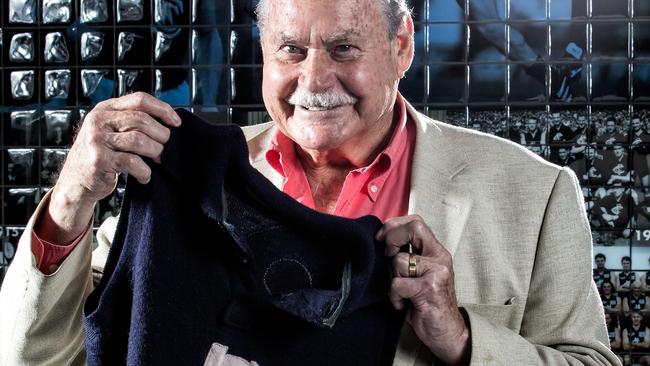
AFL
Don't miss out on the headlines from AFL. Followed categories will be added to My News.
IN football terms, it’s been called the equivalent of the “Big Bang Theory”, that one seismic moment that changed everything.
A game that had been essentially that — a game — for more than 100 years was almost turned on its axis once and forevermore in the stifling summer of 1964-65, and the aftershocks are still being felt today.
Back then, players rarely changed clubs. If they were discarded, they might try their fortunes elsewhere.
But if they were stars, they remained in the same constellation, and kids who put their heroes’ numbers on the backs of their woollen jumpers were content in the knowledge that they didn’t need their mums to unstitch them at any stage.
VIDEO: RARE FOOTAGE OF CARLTON HERO BARASSI
HOW YOUNG JUDD WAS INSPIRED BY BARASSI
Ron Barassi changed that, and 50 years on from the biggest transfer shock in the history of Australian Football, he maintains that he made the right decision.
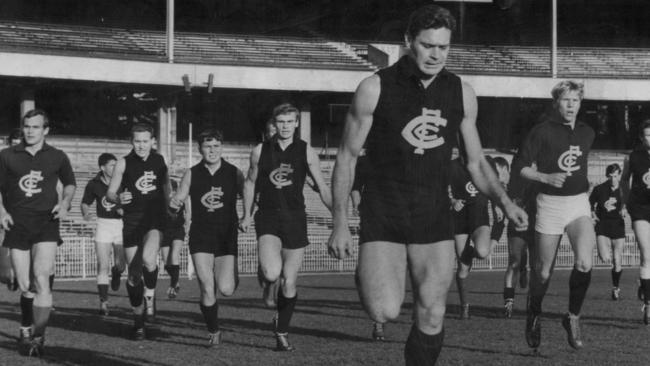
“It was probably the hardest decision I’ve ever had to make in my life,” Barassi, who turns 79 later in the month, said recently of his momentous move to Carlton.
“It was unusual at the time to have an established player leave to join another club. My whole life had been dominated by the Melbourne Football Club — it was my family as much as anything else.”
“I changed my mind a few times about the move. It was tough, but it turned out to be the best football decision I ever made.”
WATCH THE ARCHIVE FOOTAGE IN THE PLAYER ABOVE AND SCROLL DOWN TO SEE WHO’S WHO
The Sunday Herald Sun took Barassi back to Visy Park (it was Princes Park back then) to mark a half century since his dramatic shift from Melbourne player to Carlton captain-coach.
The first rumbles came just a few months after Barassi had led Melbourne to its 12th flag in 1964. Then the shock of Barassi declaring a few days before Christmas that he had decided to take up Carlton’s offer was followed by almost two months of delays as Melbourne refused to release him.
In the end, a quick-fire phone call on February 16, 1965 — 50 years ago tomorrow — finalised the biggest player switch in the game’s history, and a clear reference point for all that was to come.
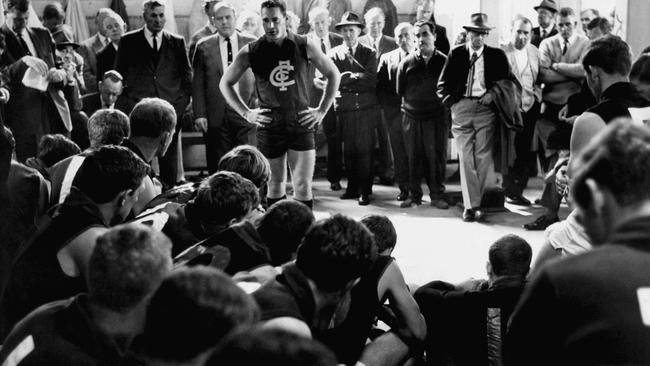
Looking back now, from an era in which free agency has further shifted the goalposts, and where superstars such as Lance Franklin, Gary Ablett and Ryan Griffin have left their long-held homes for new teams, it is hard to imagine just how significant the impact of the Barassi “defection” was at the time.
But the football Richter scale was more than just rocked.
Kids openly cried, wondering what they would do with their Melbourne No. 31 jumpers; grown men held back tears in an effort to console their sons, and a poor Melbourne supporter from Lilydale was at a loss to know what to do with the parrot she had spent months teaching to say: ‘C’mon Ron, C’mon Ron.’
“At the time I was so focused on the job ahead of me that I probably didn’t appreciate how my leaving Melbourne may have affected some people,” Barassi recalled.

To many, Barassi had been the embodiment of the Melbourne Football Club, seemingly bound by blood, past glories and the DNA of the game’s oldest and most traditional club.
Jack Dyer once wrote: “Barassi was so much Melbourne that we all believed it wasn’t a guernsey he wore, (it was) just the colour of his skin.”
Barassi’s father, Ron Jr., had been a member of the club’s 1940 premiership and was mourned heavily when he was killed at Tobruk within a year of that success, with the club promising to look after “little Ronnie”.
Melbourne made good on that promise, but Barassi gave plenty back to the Demons in return — playing 204 games, helping the club to six premierships in his time there, and being captain for five seasons, and winning two best-and-fairest awards and two club goal kicking awards.
And with Barassi at the peak of his powers, and legendary coach and mentor Norm Smith at the helm, it appeared certain the Demons would feast on further laurels.
Initially, Smith’s brother, Len, then coaching Richmond, asked Barassi in late 1964 if he wanted to coach the Tigers.
But Barassi, then 28, wasn’t even sure he wanted to coach at that stage.
“I’d seen how coaching had affected Norm and wasn’t sure that’s what I wanted,” said the man who had lived in a bungalow out the back of Norm Smith’s home for a period of time.
He said no to the Tigers.
Then, in December 1964, a “Progress Party” of Carlton businessmen and supporters, challenged for the Blues board — and won — after the club’s centenary season had finished miserably in 10th spot on the ladder.
The group, headed by George Harris, looked to interview four candidates for the coaching role — Barassi, former Magpie Murray Weideman, and Essendon greats Bill Hutchison and Jack Clarke.
WATCH THE ARCHIVE FOOTAGE IN THE PLAYER ABOVE AND SCROLL DOWN TO SEE WHO’S WHO
But Barassi was the one they truly wanted.
He recalled: “Someone from the new Carlton committee rang me to see if I was keen to coach the Blues. I was interested, so I had lunch with two committeemen near the corner of Exhibition and Lonsdale streets.
“I told them I would think it over for a few days. I rang Jim Cardwell (Melbourne’s secretary) and told him what had happened. I told him I didn’t want any advice, I just wanted everything to be confidential.”
As so happens when big footy stories gain a pulse, the news of Carlton’s bid to woo Barassi was revealed by The Herald’s Alf Brown — something that infuriated the future coach.
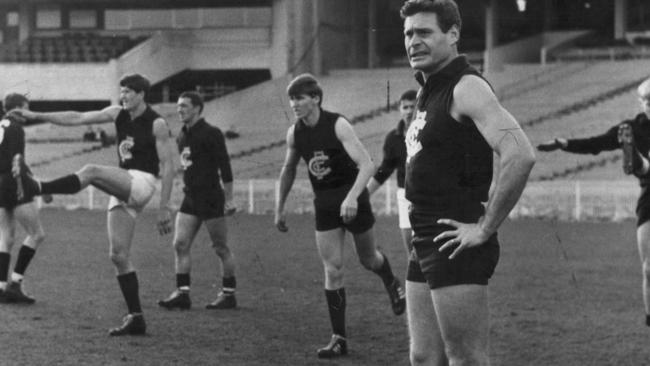
“Alf Brown rang me and he knew all the facts and figures,” Barassi said. “I rang Jim back and asked if he had told Alf, and he said he hadn’t. That left only the Carlton people. So I rang them and told them if that’s the way they operate, then I was ruling myself out of the job. I told Alf that there had been an offer to coach Carlton, but I had knocked it back.”
That all changed in the lead-up to Christmas 1964.
Barassi attended a Melbourne Football Club Christmas party at the MCG and was disappointed with the attitude of some Demons committee, who seemed frustration that he had even considered a move. And Smith even made a joke, saying: “Are you writing your own stuff in the papers now, Ron?”
Barassi said: “I went home and thought ‘Gee, I’ve just knocked back an incredible offer, and all I am getting from Melbourne are the rounds of the kitchen sink. Then I thought: ‘Bugger it; I’ll start the negotiations all over again.”
Even after agreeing to take on the Blues job, Barassi’s emotions got the better of him, and at one stage he told the Blues he would have to stay loyal to Melbourne.
Smith even offered to hand over the Melbourne coaching job to Barassi — to keep him with the Demons.
But as some people close to Barassi told him, if he proved a success with Melbourne, it would always be seen as the extension of Smith’s success. By doing it on his own at Carlton, it would his achievement alone.
“That was a big part of it,” Barassi said. “I knew it was the right time to make the move.”
Carlton’s agreement to pay Barassi 9,000 pounds over three seasons, as well as a 10,000-pound loan, also went a long way to helping to secure his -and his family’s — financial future.
Still, there was the significant matter of Melbourne agreeing to release him as a player, which was something they were extremely reluctant to do.
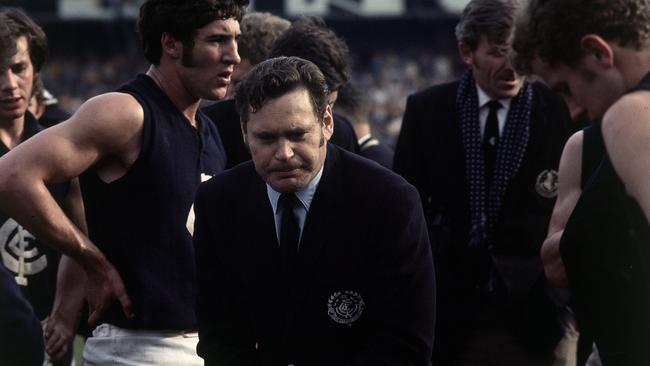
The news report confirming his appointment carried a few quotes from Melbourne’s chairman Don Duffy, who said: “A clearance application by Barassi is unlikely to be granted. Melbourne Football Club would not be happy to have Barassi playing against it.”
The standoff lasted nearly two months before the Demons finally relented, and a phone call to Princes Park late on the evening of February 16, 1965 proved the icebreaker.
Cardwell was on the other end of the line with Carlton’s secretary Gerald Burke eagerly awaiting the outcome of the Demons’ board meeting.
Just two handfuls of words put an end to it as Cardwell told an expectant Burke: “He (Barassi) is OK. Melbourne says ‘cleared with our good wishes’.”
It came after Melbourne had asked for — and received — an apology from Carlton for approaching Barassi without permission.
Football’s biggest switch was complete, and incredibly, in the half century since, Carlton has won eight flags (two of them with Barassi as coach — 1968 and 1970) and Melbourne is still waiting for that elusive 13th premiership.
The game’s brave new world was off and running.
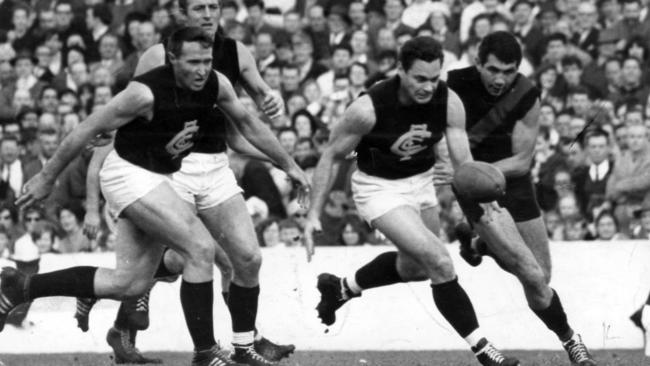
Archive footage in the video player above: Ron Barassi’s first pre-season with Carlton
Some blurred images feature Ron Barassi, officials and Carlton senior players. Graeme Emmanuel, Ian Collins and Bryan Quirk (scooting up and down the beach on a motorbike), Nicholls, Terry Board, Lofts, etc. O’Shaughnessy in chef’s hat at the barbecue; Nicholls, Gill and Sankey all playing table tennis; Barassi, Lofts and Sankey eating Dixie ice creams; committeemen Emmanuel and Gordon Newton on the beach armed with cameras; Sankey on horseback; Sankey and Collis on horseback with the horse bucking; officials including Deacon watching on; Jack Wrout capturing footage on his own home movie camera; John Gill, Barassi in Speedos and Sankey playing beach cricket;
George Harris strolling down the beach in his shades; Quirk and Collins scooting down the beach on a motorbike; Goold, Hall, Wrout, Nicholls and McEncroe watching on; Lofts left arm over, left hand bat Collis swinging lustily; Barassi sending down medium pacers off a short run; Jack Wrout (with cigarette) waving to the camera; unidentified gentleman with Allen Cowie (right); Ken Greenwood looks straight at the lens as does Kevin Hall; John Riley and Hall jump for the ball in a possible game of kick to kick; Carlton committeeman Eddie Fakhry; Lofts and Cliff Stewart in a table tennis playoff with the likes of Harris and Perc Bentley watching on; close-up of Deacon in the shade and McEncroe.



